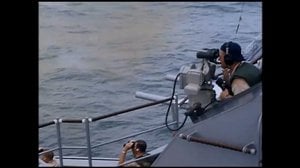
Battleship Pounds Shore Defenses, Battle of Westerplatte, 1 September 1939
Published 6 days ago
Footage of a German warship firing on Polish positions during the Battle of Westerplatte, 1 September 1939. This relatively small engagement was the opening salvo in a war that would engulf Europe for the next six years. In the aftermath of the Great War, the newly reunified Poland was granted West Prussia under the Versailles Treaty, which provided Poland with a corridor to the sea, but which separated East Prussia from Weimar Germany. Danzig, the major port, was designated as an independent fee city, ostensibly to provide Poland with port access while also protecting the rights of the predominantly German population of the city. In the early 1920s, the Second Polish Republic established a Polish Military Transit Depot on the Westerplatte Peninsula, adjacent the city of Danzig. The German Nazi party’s rise to power in 1933 resulted in a deterioration of relations between the French and Polish governments and the regime in Berlin, and Polish attempts to reinforce the garrison were met with diplomatic protests from Danzig and the German government. On 25 August 1939, the German pre-dreadnought battleship Schleswig-Holstein anchored 150 meters from the Westerplatte peninsula under the auspices of making a “courtesy call” to the city of Danzig. On the morning of September 1, the battleship fired a broadside at the Polish garrison, though the gunfire proved ineffective. Eight minutes later, a company of German Marines, which had landed two hours earlier, launched an assault against the Polish defenses but were repulsed by effective machine gun and mortar fire. When subsequent infantry attacks proved ineffective, the Germans resorted to softening Polish defenses with field artillery and air attacks, followed by two failed attempts to send burning trains into the Polish perimeter. On 7 September, with supplies running low and many of his wounded men suffering from gangrene, the Polish commander, Major Henryk Sucharski, surrendered his command. Though initially expected to defend their positions for a few hours, the Poles had managed to hold out for a week. The ship featured in this footage is a Deutschland-class pre-dreadnought battleship constructed in 1905. Pre-dreadnoughts were the dominant capital ships of major naval powers from the 1880s to the early twentieth century, and featured steel armor, coal-powered propulsion, and several big-gun batteries in armored or partially armored rotating mounts on the weather deck and supported by smaller caliber secondary batteries in casements or cupolas. Simply known as “battleships” at the time, these vessels replaced the previous generation of ironclad warships. In 1906, Great Britain’s Royal Navy commissioned HMS Dreadnought, a design that dispensed with secondary and tertiary batteries in favor of ten 12-inch guns in armored rotating turrets. This proved an evolutionary step in warship design, allowing for larger, faster, and more heavily armed capital ships capable of engaging enemy vessels at a greater distance. Battleships adhering to this “big gun” design philosophy became known as “dreadnoughts” and later as “super-dreadnoughts, while the previous generation of now outdated capital ships were referred to as “pre-dreadnoughts.” For perspective, the USS Maine, launched in 1895, was 324 feet (98.9 meters) in length, was capable of a top speed of 16.5 knots, and possesses two twin 10-inch gun mounts, six single 6-inch gun mounts, seven 6-pounder guns and four 1-pounder guns. After 1906, Maine would have been referred to as a pre-dreadnought had she not exploded in Havana, Cuba, in 1898, providing one of the catalysts for war between the United States and Spain. USS Texas, now known simply as Battleship Texas, is a New York-class super-dreadnought, is 573 feet in length, was originally capable of a speed of twenty-one knots, and featured ten 14-inch guns in five twin turrets. Texas was commissioned in 1914 and participated in combat in both world wars. The USS Wisconsin, now a museum ship in Norfolk, was the last battleship built by the United States. Commissioned in 1944, Wisconsin dwarfed her predecessors with an overall length of 887 feet, boasted six 16-inch rifles with a maximum range of 17,000 nautical miles, and featured a top speed of 32.5 knots. Wisconsin and her Iowa-class sisters were designed in the late 1930s were the pinnacle of battleship design and entered service just as battleships were relegated to obsolescence by the aircraft carrier, which emerged as the dominant capital ship during the Second World War.













